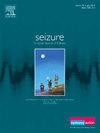Long-term outcomes of treatment with levetiracetam and valproate in idiopathic generalized epilepsy
IF 2.7
3区 医学
Q2 CLINICAL NEUROLOGY
引用次数: 0
Abstract
Objective
The aim of this study was to compare the efficacy and tolerability of valproate and levetiracetam monotherapy in patients with juvenile myoclonic epilepsy and epilepsy with generalized tonic-clonic seizure alone.
Methods
This retrospective-prospective cohort study was conducted on 170 adult patients who commenced monotherapy with valproate or levetiracetam between March 2019 and March 2023. The study outcomes were seizure-free rate, time to first seizure, retention rate, time to withdrawal and adverse events, which were registered following a one-to-five-year follow-up period.
Results
The seizure-free rates of levetiracetam and valproate were comparable in the one-year follow-up (65.9 % vs. 62.4 %, p:0.74) and in favor of levetiracetam in the five-year follow-up (90.9 % vs. 44.4 %, p:0.05). The retention rate of levetiracetam was higher than valproate (97.6 % vs. 82.4 % in the first year and 55.2 % vs. 21.6 % in the fifth year). The time to first seizure was found to be similar between the two groups (p = 0.43), but the time to withdrawal was significantly longer in patients on levetiracetam (p < 0.001). The incidence of adverse events was comparable between the two groups. However, the withdrawal rate due to adverse events was significantly higher in the valproate group. Levetiracetam demonstrated a higher occurrence of psychiatric adverse events, which were addressed with dose adjustments and psychiatric intervention in 37.6 % of patients but resulted in drug discontinuation in 3.5 % of cases.
Conclusion
The findings of this study indicate that levetiracetam monotherapy may represent an efficacious alternative to valproate in patients with juvenile myoclonic epilepsy and epilepsy with generalized tonic-clonic seizure alone, particularly in women of reproductive age.
左乙拉西坦和丙戊酸治疗特发性广泛性癫痫的长期疗效。
目的:比较丙戊酸和左乙拉西坦单药治疗青少年型肌阵挛性癫痫和单用全身性强直-阵挛性癫痫的疗效和耐受性。方法:这项回顾性前瞻性队列研究对170名在2019年3月至2023年3月期间开始使用丙戊酸盐或左乙拉西坦单药治疗的成年患者进行了研究。研究结果包括无发作率、首次发作时间、滞留率、停药时间和不良事件,这些数据是在1 - 5年的随访期后记录的。结果:左乙拉西坦与丙戊酸在1年随访期间的无癫痫发作率相当(65.9% vs. 62.4%, p:0.74),在5年随访期间左乙拉西坦的无癫痫发作率较高(90.9% vs. 44.4%, p:0.05)。左乙西坦的保留率高于丙戊酸钠(第一年97.6%比82.4%,第五年55.2%比21.6%)。两组患者的首次发作时间相似(p = 0.43),但左乙拉西坦组患者的停药时间明显更长(p < 0.001)。两组的不良事件发生率具有可比性。然而,不良事件引起的停药率在丙戊酸组明显更高。左乙拉西坦显示出较高的精神病学不良事件发生率,37.6%的患者通过剂量调整和精神病学干预解决了这些不良事件,但3.5%的病例导致停药。结论:本研究结果表明,左乙拉西坦单药治疗青少年肌阵挛性癫痫和癫痫合并全身性强直阵挛发作的患者,特别是育龄妇女,可能是丙戊酸的有效替代方案。
本文章由计算机程序翻译,如有差异,请以英文原文为准。
求助全文
约1分钟内获得全文
求助全文
来源期刊

Seizure-European Journal of Epilepsy
医学-临床神经学
CiteScore
5.60
自引率
6.70%
发文量
231
审稿时长
34 days
期刊介绍:
Seizure - European Journal of Epilepsy is an international journal owned by Epilepsy Action (the largest member led epilepsy organisation in the UK). It provides a forum for papers on all topics related to epilepsy and seizure disorders.
 求助内容:
求助内容: 应助结果提醒方式:
应助结果提醒方式:


